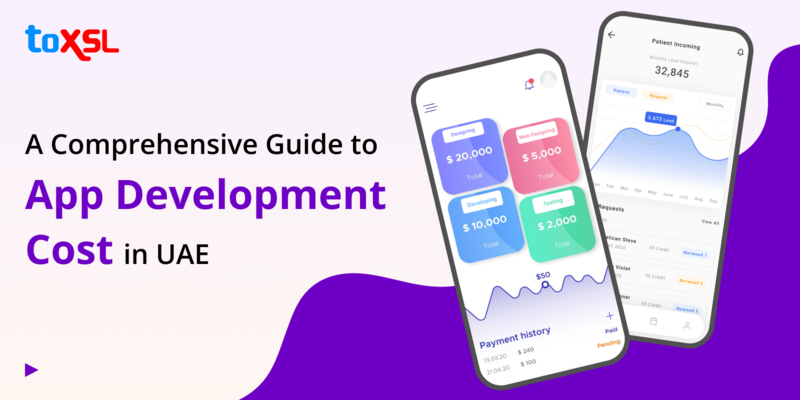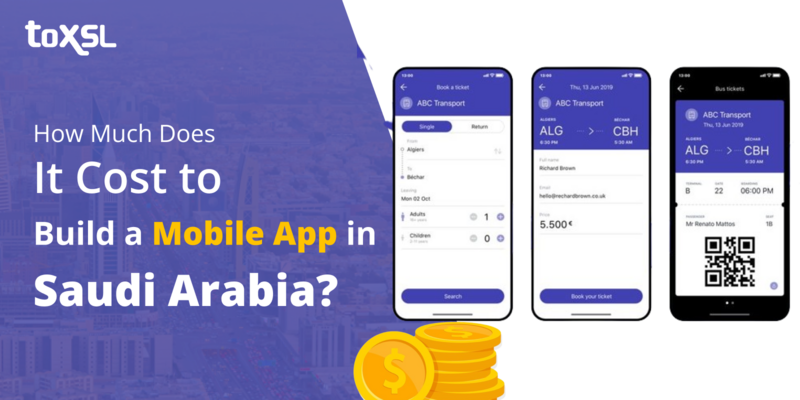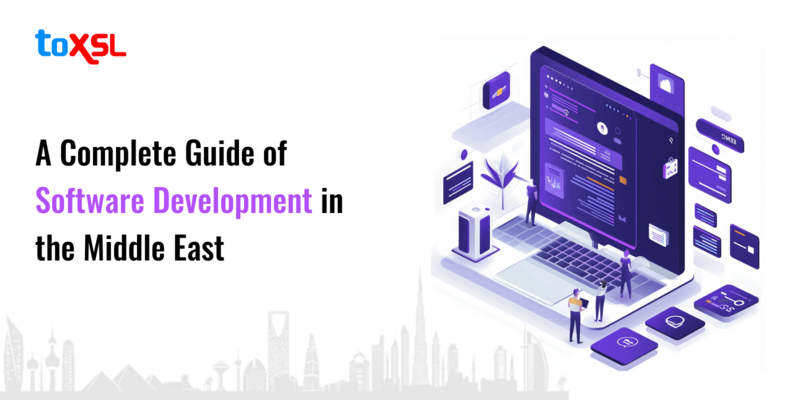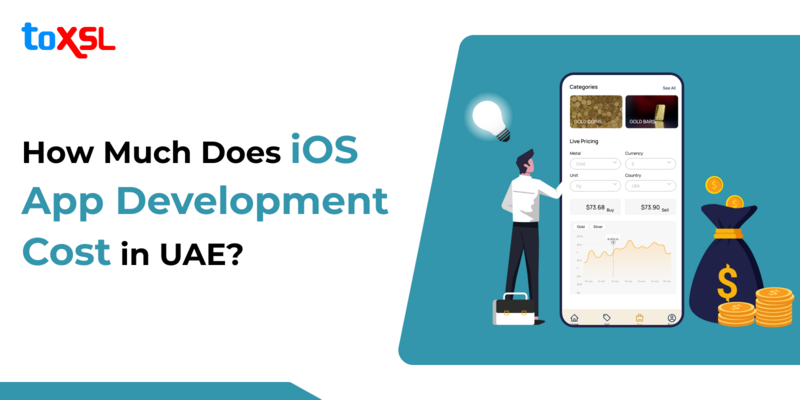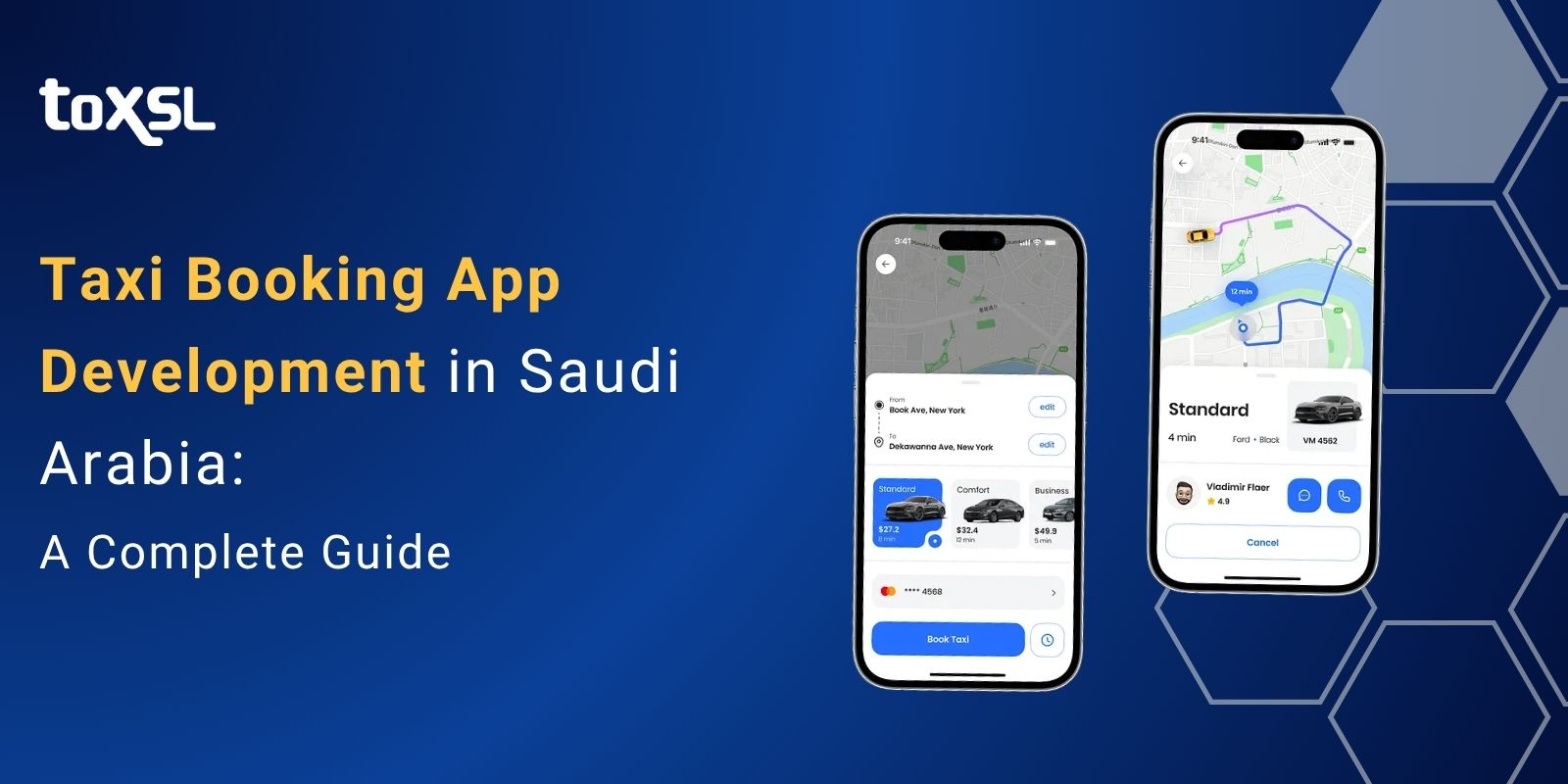
The digital transformation across the Middle East has reshaped the way people commute, and Saudi Arabia is no exception. The taxi and ride-hailing industry has witnessed tremendous growth in recent years due to the surge in smartphone usage, internet penetration, and the demand for convenient transportation solutions. At ToXSL Technologies, we specialize in taxi booking app development in Saudi Arabia, offering end-to-end solutions for startups, enterprises, and transportation service providers seeking to enter this booming market.
In this comprehensive guide, we will discuss the key aspects of developing a taxi booking app in Saudi Arabia, including features, technology stack, business models, challenges, cost estimation, and strategies to succeed in the competitive market.
Key Takeaways
- Saudi Arabia’s taxi booking market is rapidly growing, driven by urbanization, tourism, and smartphone adoption.
- Choosing the right app type—on-demand, pre-booked, ride-sharing, or specialty—is crucial for business success.
- Essential features like GPS tracking, multiple payment options, and secure driver verification enhance user experience and trust.
- Development costs vary based on app complexity, platform, features, and technology, with scalable solutions offering long-term ROI.
Understanding the Taxi Booking App Market in Saudi Arabia
Market Overview
The ride-hailing industry in Saudi Arabia has experienced rapid growth over the last decade, driven by urbanization, an increasing population, and a growing preference for on-demand mobility solutions. The market is projected to continue expanding as more people embrace mobile-based taxi booking services.
Mobile apps have transformed traditional taxi services into more convenient, efficient, and safe options for riders. This shift creates enormous opportunities for businesses to invest in taxi booking app development in Saudi Arabia.
Key Drivers of Growth
Several factors are fueling the demand for taxi booking apps in Saudi Arabia:
- Urbanization and Smart City Initiatives: With cities like Riyadh and Jeddah investing in smart city infrastructure, there is a growing need for efficient urban mobility.
- Smartphone Penetration: High smartphone adoption and widespread internet access make mobile apps a preferred choice for commuters.
- Convenience and Safety: Users prefer apps that provide real-time tracking, cashless payment, and verified drivers.
- Tourism and Business Travel: Saudi Arabia’s Vision 2030 has promoted tourism, increasing the demand for on-demand transportation solutions.
Types of Taxi Booking Apps
When it comes to taxi booking app development in Saudi Arabia, understanding the different types of apps available in the market is crucial. Each type of app serves a unique purpose and caters to specific customer needs. Choosing the right type depends on your target audience, business goals, and operational strategy. Broadly, taxi booking apps can be categorized into three main types:
1. On-Demand Taxi Booking Apps
On-demand taxi apps are the most popular and widely used type in Saudi Arabia and globally. These apps allow passengers to book a taxi instantly, directly from their smartphones.
Key Characteristics:
- Instant Ride Booking: Users can request a ride immediately, and the nearest available driver is assigned in real-time.
- GPS and Real-Time Tracking: Passengers can track the driver’s location and estimated time of arrival, enhancing convenience and safety.
- Multiple Payment Options: Integration with digital wallets, credit/debit cards, and cash payments provides flexibility.
- Dynamic Pricing: Fare can vary based on demand, distance, traffic, or special occasions.
Business Advantage:
On-demand apps generate steady revenue through frequent rides, surge pricing, and commission from drivers. They are ideal for busy urban areas where users demand quick and hassle-free transportation.
2. Pre-Booked or Scheduled Taxi Apps
Pre-booked or scheduled taxi apps allow users to reserve a taxi in advance, making them perfect for business travelers, airport pickups, or planned outings. These apps are designed for convenience and reliability.
Key Characteristics:
- Advanced Booking: Passengers can book rides hours or days in advance, ensuring a driver is available at the specified time.
- Notifications and Reminders: Users receive alerts for upcoming rides, ensuring timely pickups.
- Flexible Cancellation and Rescheduling: Allows passengers to modify bookings without inconvenience.
Business Advantage:
This type of app attracts users who prioritize punctuality and planning. It helps companies build a loyal customer base and can be combined with subscription models for premium users.
3. Ride-Sharing or Carpooling Apps
Ride-sharing apps, also known as carpooling apps, connect passengers traveling in the same direction to share a ride. These apps focus on affordability, sustainability, and reducing traffic congestion.
Key Characteristics:
- Multiple Passenger Matching: Advanced algorithms match users based on location, destination, and route.
- Cost Efficiency: Sharing rides lowers individual travel costs while promoting eco-friendly commuting.
- Social Interaction: Passengers can opt to share rides with friends, colleagues, or other verified users.
Business Advantage:
Ride-sharing apps appeal to cost-conscious commuters and environmentally conscious users. They also reduce idle rides for drivers, increasing efficiency and revenue.
4. Specialty Taxi Apps (Optional Advanced Category)
Some taxi booking apps focus on specific niches, catering to unique customer needs in Saudi Arabia. Examples include:
- Women-Only Taxi Apps: Prioritize safety and convenience for female passengers.
- Luxury or Premium Ride Apps: Offer high-end vehicles and premium services for corporate clients or tourists.
- Accessible Taxi Apps: Designed for people with disabilities, featuring specially equipped vehicles and trained drivers.
Business Advantage:
Specialty apps allow companies to target underserved segments, differentiate their services, and create a competitive edge in a saturated market.
Essential Features of a Taxi Booking App
A successful taxi booking app in Saudi Arabia requires a set of robust features for riders, drivers, and administrators.
Rider App Features
User Registration and Profile Management: Easy and secure login through email, phone, or social media.
Geolocation and GPS Tracking: Accurate tracking for pick-up and drop-off locations.
Ride Booking and Scheduling: Options for instant or pre-scheduled rides.
Fare Estimation: Transparent fare calculation based on distance, traffic, and time.
Multiple Payment Options: Integration with digital wallets, cards, and cash.
Ride History and Ratings: Users can check past trips and rate drivers.
Push Notifications: Updates on ride confirmation, driver arrival, and promotions.
Driver App Features
Driver Registration and Verification: Secure onboarding and vehicle verification.
Ride Requests and Navigation: Efficient ride management and GPS navigation.
Earnings and Incentives: Real-time earnings dashboard and incentive tracking.
Availability Management: Toggle availability to accept or reject rides.
Ratings and Feedback: Insights on performance and user ratings.
Admin Panel Features
Dashboard Management: Monitor riders, drivers, bookings, and payments.
Analytics and Reports: Insights on revenue, trends, and user behavior.
Pricing and Surge Management: Adjust fares dynamically based on demand.
Promotions and Offers: Manage discounts, referral programs, and loyalty rewards.
Dispute Management: Handle complaints and refunds efficiently.
Technology Stack for Taxi Booking App Development
A scalable and efficient taxi booking app requires a strong technology foundation. At ToXSL Technologies, we use modern and reliable technologies tailored to your business requirements.
Front-End Technologies
iOS: Swift, Objective-C
Android: Kotlin, Java
Cross-Platform: Flutter, React Native
Back-End Technologies
Server-Side: Node.js, Python (Django/Flask), PHP (Laravel)
Database: MySQL, MongoDB, PostgreSQL
Cloud Hosting: AWS, Google Cloud, Microsoft Azure
APIs and Integrations
Google Maps API for navigation and geolocation
Payment gateways such as PayPal, Stripe, and Mada
SMS/Email notifications via Twilio or SendGrid
Analytics and performance monitoring via Firebase or Google Analytics
Business Models for Taxi Booking Apps
Selecting the right business model is critical for profitability and sustainability.
Commission-Based Model: The app earns a percentage of each ride completed by drivers.
Subscription Model: Users or drivers pay a subscription fee for premium features.
Dynamic Pricing Model: Fares fluctuate based on demand, supply, or peak hours.
Advertisement-Based Model: Revenue generated through in-app ads or promotions.
Each model can be combined or customized based on market requirements and business strategy.
Steps to Develop a Taxi Booking App in Saudi Arabia
Developing a successful taxi booking app in Saudi Arabia requires a strategic, step-by-step approach that ensures the app is not only functional but also scalable, secure, and user-friendly. At ToXSL Technologies, we follow a comprehensive development roadmap to deliver high-quality taxi booking solutions that meet market demands and exceed user expectations.
Conduct Thorough Market Research and Analysis
The first step in the development process is to understand the Saudi Arabian market landscape. Conduct detailed research on user behavior, competitor apps, and emerging trends in the ride-hailing industry. Identify gaps in the market that your app can fill, and analyze the features, pricing models, and user experiences of existing solutions like Uber and Careem. Understanding regulatory requirements and local laws regarding taxi operations is also crucial to ensure compliance.
Define App Features and Requirements
Once market research is complete, outline the core and advanced features of your taxi booking app. This includes functionalities for the rider app, driver app, and admin panel. Decide whether the app will be on-demand, pre-booked, ride-sharing, or a combination. Selecting the appropriate business model—whether commission-based, subscription-based, dynamic pricing, or advertisement-driven—will help guide your app development and monetization strategy.
UI/UX Design and Prototyping
User experience plays a significant role in the success of a taxi booking app. Design intuitive interfaces that make booking rides, making payments, and tracking vehicles seamless for users. Prototypes should be created and tested for ease of navigation, accessibility, and visual appeal. At ToXSL Technologies, we focus on creating clean and responsive designs that enhance user satisfaction and engagement.
Back-End and API Development
The backbone of a taxi booking app lies in its back-end architecture. Develop a robust and scalable server infrastructure that can handle multiple simultaneous ride requests without lag. Integrate essential APIs such as Google Maps for GPS navigation, payment gateways for secure transactions, SMS and email notifications for communication, and analytics tools to track app performance and user behavior. This stage ensures that the app functions smoothly under all conditions.
Testing and Quality Assurance
Before launch, conduct rigorous testing to ensure the app is free of bugs and functions as expected. Perform functional testing to check all features, performance testing to handle peak loads, security testing to protect user data, and usability testing to confirm an intuitive experience. Continuous testing ensures that the final product is reliable, secure, and ready for the competitive market.
Launch and Deployment
After successful testing, deploy the app on the Apple App Store, Google Play Store, or private enterprise platforms. Ensure smooth onboarding with tutorials or guides for new users. At this stage, having a reliable customer support system is essential to address user queries, resolve issues, and maintain high satisfaction levels.
Marketing and User Acquisition
A well-planned marketing strategy is key to attracting users in Saudi Arabia’s competitive ride-hailing market. Promote your app via social media campaigns, search engine optimization (SEO), influencer partnerships, and referral programs. Collaborate with local businesses, hotels, and airports to expand user reach. Effective marketing ensures visibility, downloads, and user retention, paving the way for a successful launch.
Continuous Monitoring and Updates
Post-launch, it is crucial to continuously monitor app performance, user feedback, and market trends. Regularly update the app with new features, improvements, and security enhancements. Continuous optimization keeps your app relevant, competitive, and aligned with evolving user expectations.
Cost Estimation for Taxi Booking App Development
One of the most critical considerations when planning taxi booking app development in Saudi Arabia is understanding the cost involved. The overall cost depends on various factors such as app complexity, platform selection, features, design, technology stack, and post-launch maintenance. At ToXSL Technologies, we provide transparent and tailored solutions that fit different business budgets while ensuring high-quality development.
Factors Affecting the Cost
Several key factors influence the total development cost of a taxi booking app:
App Complexity and Features: A basic app with essential features like ride booking, GPS tracking, and payment integration will cost less than an app with advanced features such as AI-based route optimization, in-app chat, predictive analytics, and loyalty programs. The number and sophistication of features directly impact the development hours and, consequently, the cost.
Platform Selection: The choice of platform significantly affects the cost. Developing a native app for iOS and Android separately is generally more expensive than creating a cross-platform app using frameworks like Flutter or React Native. Businesses targeting both Android and iOS audiences should consider either a native approach for better performance or a cross-platform solution for cost efficiency.
Design and User Experience: Custom UI/UX design that is intuitive, attractive, and responsive requires additional investment. High-quality designs enhance user engagement and retention but may increase development costs due to additional design iterations, animations, and interactive elements.
Back-End Infrastructure and APIs: A robust and scalable back-end system capable of handling multiple users, real-time requests, and large amounts of data will require more development resources. Integrating APIs for maps, payments, notifications, and analytics also adds to the overall cost.
Geographical Location of Development Team: Development costs vary based on the location of the development team. Hiring local developers in Saudi Arabia may be more expensive than outsourcing to regions with lower hourly rates. However, working with experienced local teams like ToXSL Technologies ensures cultural and market understanding, timely communication, and high-quality deliverables.
Maintenance and Updates: Post-launch maintenance, updates, server costs, and marketing campaigns are recurring expenses. Regular updates for security patches, feature enhancements, and system optimizations ensure long-term app success but should be factored into the total budget.
Estimated Cost Range
Based on the factors above, the approximate cost for developing a taxi booking app in Saudi Arabia is categorized as follows:
Basic App Development: $15,000 – $30,000
This includes essential features for riders and drivers, simple UI/UX design, basic payment integration, and a functional admin panel. Ideal for startups testing the market.
Medium Complexity App Development: $30,000 – $50,000
This tier includes advanced features such as ride scheduling, in-app chat, fare estimation, push notifications, and moderate design customization. Suitable for businesses aiming to provide a competitive and reliable service.
High-End Custom Taxi Booking App: $50,000+
High-end apps incorporate AI-based route optimization, predictive analytics, loyalty programs, multi-language support, custom design, and enterprise-grade backend infrastructure. These solutions are ideal for large-scale operations or apps targeting premium market segments.
Ways to Optimize Development Costs
Businesses can adopt strategies to manage and optimize taxi app development costs without compromising quality:
Start with MVP (Minimum Viable Product): Launch an app with core features first, gather user feedback, and gradually add advanced features. This reduces initial investment and validates market demand.
Choose Cross-Platform Development: Utilizing frameworks like Flutter or React Native allows businesses to deploy apps on both Android and iOS with a single codebase, reducing development time and cost.
Use Pre-Built Modules: Incorporate ready-made APIs and libraries for features like payments, maps, and notifications to minimize development effort and cost.
Partner with Experienced Development Teams: Working with experienced companies like ToXSL Technologies ensures efficient development, reduces errors, and avoids unnecessary costs related to trial-and-error approaches.
Challenges in Taxi Booking App Development
Developing a taxi booking app in Saudi Arabia comes with unique challenges:
Regulatory Compliance: Adhere to local transportation laws and licensing requirements.
High Competition: Compete with established players like Uber and Careem.
Scalability: Ensure the app can handle peak traffic and growing user base.
Payment Integration: Provide secure and seamless payment options.
User Trust and Safety: Verify drivers, provide emergency alerts, and protect user data.
Conclusion
The taxi booking industry in Saudi Arabia offers immense opportunities for businesses that embrace technology and customer-centric solutions. ToXSL Technologies excels in taxi booking app development in Saudi Arabia, providing feature-rich, scalable, and customized solutions for startups and enterprises.
From on-demand booking to AI-powered route optimization, we deliver apps that enhance operational efficiency, ensure safety, and offer superior user experiences. Partner with ToXSL Technologies to build a taxi booking app that drives growth, meets market demands, and establishes your presence in Saudi Arabia’s thriving mobility sector.
FAQ's
1. How long does it take to develop a taxi booking app?
Development time ranges from 3 to 6 months for basic apps, while high-end custom apps with advanced features can take 6 to 12 months, including testing and deployment.
2. How can AI improve taxi booking app performance?
AI optimizes route planning, predicts demand, reduces waiting times, improves fare estimation, and enhances user experience by offering smarter ride allocation and operational efficiency.
3. How can a taxi booking app attract and retain users?
Implement loyalty programs, referral incentives, multilingual support, push notifications, promotions, and smooth UI/UX to ensure convenience, reliability, and engagement.
4. How can predictive analytics benefit a taxi booking app?
Predictive analytics forecasts demand patterns, peak hours, and high-traffic zones, enabling better ride allocation, improved revenue, and enhanced user satisfaction.
5. How does multi-language support impact user experience?
Supporting Arabic and English allows broader accessibility, enhances user convenience, and caters to both local residents and international travelers in Saudi Arabia.

